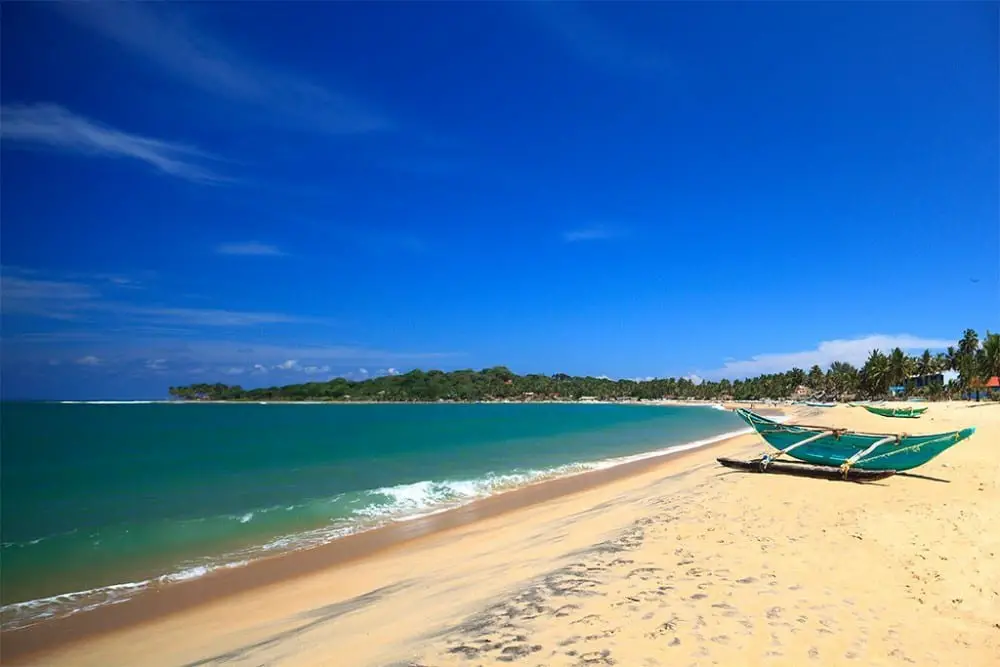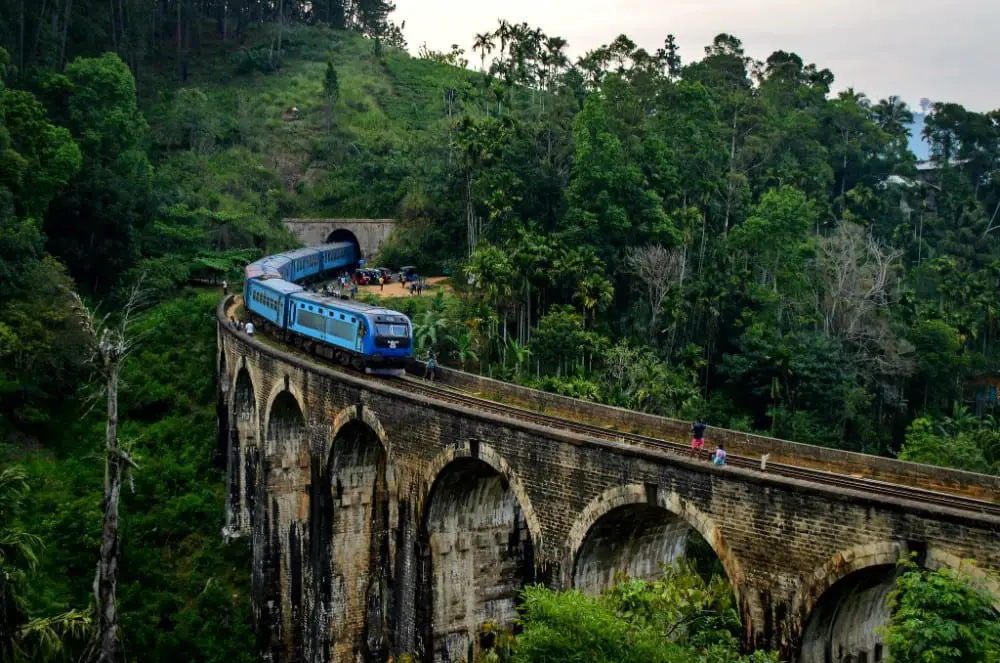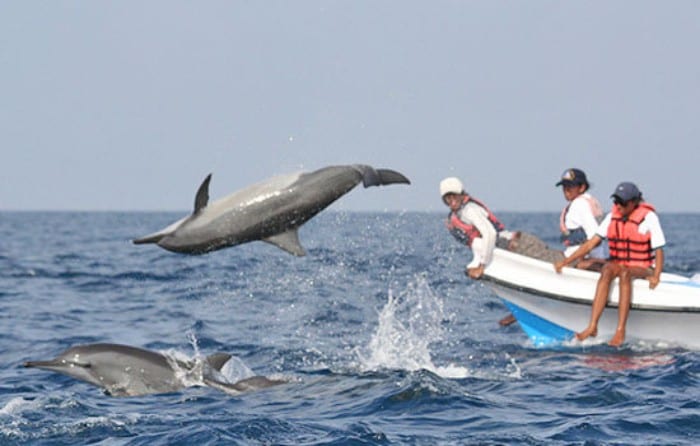Sri Lanka has been one of the fastest growing travel destinations in the world over the past decade or so. Visitors are waking up to the island’s charms with everything from stunning beaches, mountain scenery and ancient culture to be discovered. Our Sri Lanka backpacking route packs in a little bit of each but it could easily be tailored according to your preferences.
Table of Contents
- Backpacking Sri Lanka – A 3 Week Itinerary
- Fly in to the Capital
- Backpacking Southern Sri Lanka (One Week)
- The Highlands & The Cultural Triangle (10 Days)
- Western Coast (3/4 days)
- Sri Lanka Backpacking Tips & FAQs
Sri Lanka Itinerary Overview
How long does it take to backpack Sri Lanka?
We suggest allowing about 3 weeks for the Sri Lanka backpacking itinerary outlined below. There are some suggestions for shortening or extending the route at the bottom of this page.
Sri Lanka Backpacking Budget
Possible Shoestring Budget for this Itinerary: £350 €400 $450
This is based on three weeks of travel and opting for genuine budget/backpacker accommodation and transport throughout. It will require some discipline to stick to it but overall Sri Lanka is a very affordable destination and it shouldn’t be impossible if you have some experience of shoestring travel. For a more relaxed trip that will enable you to stay in slightly better accommodation and do more activities, consider upping your budget to $600-700.
March 2020 prices & exchange rates are used for these figures and they don’t include the cost of flights in or out of the country which can be a lot. There may be slight variations depending on when you visit – particularly in the more touristy beach areas where prices can rise during peak season.
Read our article on the cost of travel in Sri Lanka for more info and sample prices.
Backpacker Jobs in Sri Lanka
Use Worldpackers to search for short-term work placements in Sri Lanka (there are lots of hostel and hotel placements as well as some English teaching roles). As well as the experience, it’s a nice way to save money and extend your trip as at the very least you should get free accommodation and free meals.
Travel Insurance for backpacking Sri Lanka
The cost of travel insurance isn’t included in the budget figures above. You can get a quote in less than a minute from Heymondo who provide well reviewed travel insurance for backpacking Sri Lanka and other countries.
Backpacking Sri Lanka – A 3 Week Itinerary
Our Sri Lanka backpacking route is basically one big loop with the start and end points both located close to the country’s main international airport. Therefore it probably makes sense to just book a return flight to Colombo if your trip solely revolves around visiting Sri Lanka.
Note that you could easily do this trip in reverse should you prefer and first head north from Colombo to Negombo before cutting back round through the Cultural Triangle and Central Highlands before finishing your trip on the South Coast.
Fly in to the Capital
1. Colombo
Bandaranaike International Airport, located 30 km north of the capital, is the main entry port into not just Colombo but the island of Sri Lanka. With 5.5 million people living in its metropolitan area, Colombo is by far the biggest city in the country. It isn’t really one of Sri Lanka’s main travel highlights though and most backpackers tend to limit their time here or merely pass through it to find a transport connection to their first destination.
If you do decide to hang around for a day or so, the The National Museum of Colombo and the Vihara Buddhist Temple are among the best options for things to do.
Backpacking Southern Sri Lanka (One Week)
2. Hikkaduwa

Just over 100 km south of Colombo, you start to hit the gorgeous beaches of southern Sri Lanka with Hikkaduwa one of the first and liveliest you will find. It has been a popular destination with surfers since the 1970’s and it has an international vibe with lots of options for daytime activities including snorkelling, surfing and lagoon safaris. There is also a turtle farm which protects, feeds and hatches turtles.
It has been described as the party capital of Sri Lanka or the country’s equivalent of Goa in India. However it’s worth adding the large caveat that this is not really a party island so anyone expecting the kind of wild scene that you find in Southeast Asia may be disappointed.
3. Galle
The historic city of Galle is a must visit destination for anyone travelling in Sri Lanka. This quirky town offers a much more relaxed and enjoyable urban experience than you get in Colombo. The mix of Portuguese and Dutch architecture gives it a really unique feel while its 16th Century fortress is the main attraction. You can also cycle or take a bus to the nearby beach hamlet of Unawatuna which is known for its delicious seafood.
4. Weligama/Mirissa
Mirissa is another popular coastal stop on the Sri Lanka backpacking trail with colourful streets and plenty of hostels. From there you can rent out a scooter or bike which will help you get out to the more secluded beaches where you can enjoy a little piece of paradise all to yourself.
You could also opt to base yourself in Weligama, a slightly larger town 7 km along the coast in the direction of Galle. Historically a fishing village, it attracts plenty of travellers who come for surfing, scuba-diving and whale watching. The blue whale – the largest mammal on Earth – can sometimes be seen in its waters.
The Highlands & The Cultural Triangle (10 Days)
5. Ella

Heading inland and uphill, the next week or so will be spent exploring the Sri Lankan highlands starting in the backpacker hub of Ella. It’s a great base for going on hikes in the surrounding countryside and trips to sights such as the spectacular Rawana Ella or Diyaluma Falls and the British-era Demodara Bridge AKA the Nine Arches bridge. You can also take a day-trip to the mountain retreat of Haputale, famous for its tea fields and estates.
6. Nuwara Eliya
50 km west of Ella lies the town of Nuwara Eliya, right in the heart of Sri Lanka’s ‘Hill Country’. Its temperate climate comes as a real contrast to the heat and humidity of the coastal regions with more great hikes, temples and tea plantations to be discovered in the surrounding areas.
7. Kandy
Continuing north through Central Province, you will eventually reach Kandy which is largely viewed as Sri Lanka’s cultural capital. While it is the country’s second largest city, the centre is quite compact and easily explored on foot with the cooler mountain air helping matters.
It has more attractions and things to see and do than any other destination on this Sri Lanka backpacking itinerary. Highlights include the Temple of the Tooth, a holy Buddhist Shrine, home of what is said to be the tooth of Lord Buddha. The city is also home to numerous lush parks and gardens while the Pinnawala Elephant Orphanage is a popular stop with travellers.
8. Dambulla & Sigiriya
North Central Province is the location of the ancient kingdoms of Sri Lanka with over 2000 years of history packed into a small area. Both Dambulla & Sigiriya lie within the so-called Cultural Triangle which includes 5 of Sri Lanka’s 8 UNESCO World Heritage sites.
Dambulla is best known for its golden cave temple. Nearby Sigiriya has slightly more to see and do and is probably a better base for travellers with the imposing Sigiriya Rock fortress its main attraction. If you’re after more in the way of wildlife, then head further out to Kaudulla National Park. Habarana and Polonnaruwa are also possible day or half-day trips from here.
9. Anuradhapura
Anuradhapura forms the northern tip of Sri Lanka’s Cultural Triangle and is a worthwhile final stop before heading back to the coast. This ancient city was Sri Lankas’s first kingdom. For the best views of it, head to the nearby mountain peak Mihintale which can be reached by tuk-tuk or bike.
Western Coast (3/4 days)
10. Kalpitiya

Back on the coast for a few more beach days before ending our Sri Lanka travel itinerary. The Kalpitiya peninsula has a slightly more undiscovered feel than the more touristy southern beaches. The saltwater lagoons attract kitesurfers and kayakers while nature enthusiasts may want to head out to the Wilpattu National Park – one of the best locations for spotting the Sri Lankan leopard.
11. Negombo
Negombo has a wide beach to relax on if you want a peaceful end to your trip but it’s also a relatively lively city. Head to the fish market or check out the boats lining up in the lagoon for an idea of what makes this city tick.
Located even closer to Bandaranaike International Airport than Colombo is, it’s a natural ending point for the trip with plenty of onward flight connections.
Check out our other Asia backpacking routes!
southeast asia | thailand | myanmar | vietnam | laos | indonesia | philippines | cambodia | india | taiwan | sri lanka | japan | malaysia
Sri Lanka Backpacking Tips & FAQs
Visa Requirements for Sri Lanka
Visitors to Sri Lanka must obtain a 30-day Electronic Travel Authorization (ETA) either online or on arrival. The former is the recommended method to avoid queues at check-in. At the time of writing (March 2020), Sri Lanka is currently trialling a new system where residents of a large number of countries (includes all EU members, UK, USA, Australia, Canada & New Zealand) can get the ETA free of charge.
There is more info on how to apply here.
Travelling to Sri Lanka from India
Many and perhaps most backpackers in Sri Lanka have either come from or are later going to India. At the closest point, it’s only around 20 km between the west coast of Sri Lanka and the Indian mainland but it’s frustratingly difficult to get between the two countries without flying. There used to be a ferry service from the Indian city of Tuticorin but as of March 2020, there are no passenger services between the two countries and cargo ships are not allowed to carry passengers.
In short, you will basically have to fly between the two countries unless the situation changes. Colombo-Bandaranayake International Airport is the main entry point to Sri Lanka and we’ve planned the above route around entering and departing the country by flying in and out of it. There are direct connections to a host of Indian cities including Bangalore, Chennai, Hyderabad, Mumbai, Kochi and Delhi. Prices are on the steep side though in contrast to the very affordable cost of domestic travel in each country.
How does Sri Lanka compare to India?
Overall, Sri Lanka is a far more relaxed and less frenetic place than India. Its population of just over 20 million is the equivalent of only 1.5% of India’s and outside Colombo at least, there is rarely that sense of chaos and not being able to escape the huge crowds. Around 70% of Sri Lankans are Buddhists which is another major difference from predominantly Hindu India.
However there are many similarities between the two as well. Sri Lanka gained independence from Britain in 1948, a year after its large northern neighbour. Like in India, that British heritage is most clearly demonstrated today by the nation’s love of cricket as well as an extensive rail network which makes it easy although not always quick to get around with the hilly central areas particularly tough to navigate.
Despite its peaceful nature, Sri Lanka’s recent history has at times been a violent one with a 26 year civil war only ending as recently as 2009 with the government defeating the Tamil Tiger rebels. More recently still, the 2019 Easter Bombings by Islamic extremists targeted the country’s tourism industry and killed 259 people. It has predictably had a knock on visitor numbers.
Is Sri Lanka good for Backpacking?
Sri Lanka is great value on the whole and there’s loads to see and do making it a really appealing destination for budget travellers. The relatively small size of the country coupled with cheap transport costs by road and rail makes getting around very affordable and besides the flights in and out, you shouldn’t be spending much at all on getting from A to B.
Sri Lanka is though still behind India and certainly SE Asia in terms of overall infrastructure for backpackers. Independent travellers were previously put off the country by the long civil war so it has only really been in the last decade that a backpacking scene has started to develop.
In the most popular destinations you shouldn’t struggle to find budget hostel-style accommodation but there are relatively few dorm options in comparison to other countries and if you step off the beaten track, you may find yourself having to fork out for a private room which can lead to travel here being marginally more expensive than in India.
Things are changing though with more typical backpacker-style accommodation and facilities opening up each year.
Extending your Trip & Getting off the beaten track
The above Sri Lanka backpacking route aims to cover the main travel highlights of the country but there are plenty of options for extending it and getting off the beaten track.
While there are a few beach resorts dotted around, the East Coast doesn’t get anywhere the same number of visitors and makes for more of an adventure, particularly if you have your own form of transport – it’s possible to rent and drive your own tuk-tuk in Sri Lanka. The Arugam Bay area is one area that some travellers and particularly surfers head for.
Meanwhile on the northern tip of the island, Jaffna is a decent target for anyone keen to explore the whole island. It is the cultural home of the Tamil people with numerous temples and ancient forts as well as plenty more sandy beaches although there isn’t much in the way of backpacker accommodation or facilities.
The most obvious way to extend your trip is to hop over to India and continue travelling there. Our India backpacking route outlines a two month itinerary that covers large chunks of the country.
Shortening the Route – 1 & 2 Week Backpacking Itineraries for Sri Lanka
Sri Lanka is small enough that you could do the above route in one or two weeks and just skip the destinations that don’t appeal as much.
If you only have one week, it may be sensible though to just choose between either exploring the western and southern coastal regions or going for an inland adventure through the Central highlands. The beach route could simply follow the above itinerary but turn around at Weligama/Mirissa and head back to Colombo for the flight out. The inland route could see you do a Colombo-Anuradhapura-Ella triangle but it may feel a bit rushed so 10 days would be better in this case to make sure you have enough time to really see the best of the likes of Nuwara Eliya and Kandy.
A two week backpacking itinerary for Sri Lanka could more easily follow the same path outlined above. At a push you could squeeze in all the destinations but it’s probably better to skip the last two and end your itinerary at Anuradhapura or perhaps even Dambulla/Sigiriya for a quicker connection back to Colombo.
When to visit Sri Lanka
We have a separate article on when to visit Sri Lanka and the answer will depend on which areas you want to visit and what kind of trip you are looking for. Although it is only a small island, there are some significant climatic differences between different regions. Overall, January to March might be seen as the optimum time to do the route above although you may find accommodation prices rise due to it being peak season.
This Sri Lanka backpacking itinerary was published in April 2020.
Please use the comments section below for questions.

